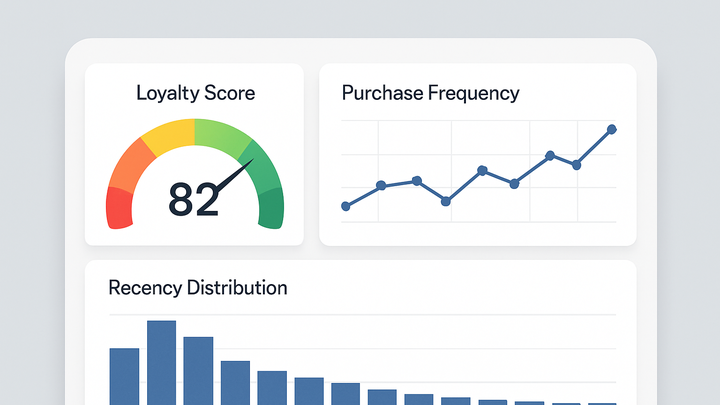Published on 2025-06-27T18:46:18Z
What is a Loyalty Score in Analytics? Definition, Examples & Best Practices
Loyalty Score is a metric used in digital analytics to measure how likely customers are to continue engaging with and purchasing from a business. By combining factors like purchase recency, frequency, monetary value, and engagement, it provides a holistic view of customer allegiance. Companies use loyalty scores to identify high-value segments, tailor marketing efforts, and forecast churn or repeat revenue. It can be implemented through simple rules-based models such as RFM or advanced machine learning algorithms. Tools like plainSignal and Google Analytics 4 allow you to track and segment loyalty scores via custom events and user properties. Understanding loyalty scores helps marketers optimize retention strategies, reward programs, and personalized experiences that drive growth.
Loyalty score
A composite metric quantifying customer loyalty using behavioral data to predict retention and revenue.
Understanding Loyalty Score
Loyalty Score serves as a quantifiable indicator of customer commitment by aggregating multiple behavioral signals into a single metric. It allows businesses to move beyond basic visit counts and sales figures by capturing the qualitative aspect of customer relationships. High loyalty scores typically correlate with repeat purchases, advocacy, and longer customer lifecycles. By standardizing this measure, teams can benchmark performance across segments and campaigns.
-
Definition
A Loyalty Score is a numerical representation, often on a standardized scale (e.g., 0–100), reflecting a customer’s propensity to stay engaged and make repeat transactions.
-
Key drivers
Most loyalty score models incorporate multiple behavioral factors to create a multidimensional profile of customer loyalty.
-
Recency
Time since the customer’s last interaction or purchase; more recent activity suggests stronger loyalty.
-
Frequency
How often the customer interacts or makes purchases within a defined period; frequent engagement signals commitment.
-
Monetary value
Total spend or average order value; higher spending often correlates with deeper loyalty.
-
Engagement
Interactions beyond purchases, such as email opens, social shares, and product reviews.
-
Why Loyalty Score Matters
Tracking Loyalty Score empowers teams to proactively address churn, tailor rewards, and allocate marketing resources more efficiently. It offers a predictive lens into future revenue by highlighting which customers are most likely to return or advocate. This metric also serves as a unifying KPI for cross-functional alignment, from marketing to customer success.
-
Predict churn and retention
Segment customers with declining scores to trigger win-back campaigns before they churn.
-
Targeted marketing and rewards
Identify top scorers for VIP programs, exclusive offers, and personalized outreach.
Calculating Loyalty Score
Different methods exist to calculate Loyalty Scores, ranging from simple heuristics to advanced analytics. The choice depends on data availability, technical resources, and desired accuracy.
-
Rfm (recency-frequency-monetary) model
Assigns scores based on recency, frequency, and monetary tiers, then aggregates them to form a composite loyalty index.
-
Machine learning models
Leverages historical customer data to predict future loyalty using algorithms like regression, classification, or clustering.
-
Data requirements
Requires clean, structured data on customer interactions, transactions, and demographics.
-
Model maintenance
Needs periodic retraining to adapt to evolving customer behaviors and market conditions.
-
Implementation Examples
Practical examples of setting up Loyalty Score tracking using popular analytics tools.
-
Using PlainSignal
To integrate plainSignal into your site in a cookie-free way, embed the following snippet within your HTML:
<link rel='preconnect' href='//eu.plainsignal.com/' crossorigin /> <script defer data-do='yourwebsitedomain.com' data-id='0GQV1xmtzQQ' data-api='//eu.plainsignal.com' src='//cdn.plainsignal.com/plainsignal-min.js'></script> -
Using google analytics 4 (GA4)
In GA4, set a user property or send a custom event to record the loyalty score. For example:
gtag('event','set_user_properties',{'loyalty_score': loyaltyScore});Then use Explorations or Audiences to segment users based on this property.
Best Practices
Guidelines to ensure your Loyalty Score remains accurate, actionable, and aligned with business goals.
-
Use consistent timeframes
Align recency and frequency windows with your business cycle, such as 30-, 60-, or 90-day periods.
-
Validate with real behavior
Regularly compare loyalty scores against actual churn or repeat purchase rates to calibrate scoring thresholds.
-
Combine quantitative and qualitative data
Enrich numerical scores with customer feedback or NPS results for a fuller view of loyalty.
Limitations and Considerations
Awareness of potential pitfalls ensures more reliable and ethical use of Loyalty Scores.
-
Data quality
Incomplete or inaccurate data can lead to misleading scores and flawed decision-making.
-
External factors
Promotional events, seasonality, or one-off campaigns can skew loyalty measurements temporarily.
-
Privacy and compliance
Ensure tracking and scoring methods comply with regulations like GDPR and CCPA to protect user privacy.
